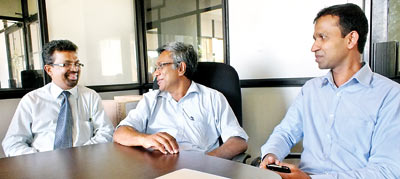Technological breakthrough to identify the dead in natural and manmade disasters in Sri Lanka

Picture shows the Face ID team leaders: From left – Dr. Muditha Vidanapathirana, Dr Dhamitha Karunaratne and Dr K D Sandaruwan
When disasters – natural and manmade – occur deaths happen and piles of dead bodies cannot be identified. Also in accidents and murders with the facial damage, identification would be difficult. In cultures like in Sri Lanka, more than capturing the person who committed the crime, the relatives are more concerned about giving a dignified burial for the dead person and difficulty in identifying the dead body precludes such a burial.
The Colombo University School of Computing (CUSC), Faculty of Medicine, Sri Jayawardenapura University and the University of Visual Performing Arts Colombo along with the National Science Foundation (NSF) are now undertaking a research study on Facial Reconstruction of unidentified dead bodies. The project is now in final stages as the test runs have been successful. This would also explore the possibility of commercialising and marketing the Face ID Process.
The Black July riots in 1983, youth uprisings in 1971 and 1987, two decades of civil war and the 2004 Tsunami that left more than 35,322 dead were disasters faced by Sri Lanka in recent times. Due to Tsunami, the Karapitiya Teaching Hospital handled over 1,100 deaths and around 450 out of the number were unidentified and sent for mass burial. When unidentified dead bodies are found in disasters they are sent to mass graves. To find out more about this unique project FaceID or 3D (Dimension) Computer Graphics based Solution for Forensic Facial Reconstruction for Sri Lanka, recently the Business Times (BT) along with an NSF Scientific Officer visited the CUSC at Reid Avenue.
Dr. Damith Karunaratne, Principal Investigator, CUSC; Co-investigators – Dr, Muditha Vidanapathirana, Department of Forensic Medicine, Faculty of Medicine, University of Sri Jayawardenapura and Dr. Damitha Sandaruwan, CUSC; Research Staff – R. N. Rajapakse, UCSC; Nadun D Liyanage, Sri Lanka Institute of Information Technology; Rasika Ranepura, UCSC; and 3D Sculptor, Nuwan Dhammika, University of Visual Performing Arts were all there around a round table at the UCSC Centre in front of a huge computer screen to show the BT the potential of Face ID commercialisation where the support of NSF comes in. This project was first initiated by Dr. (Ms) Anuja Dharmaratne of the CUSC.
Dr. Karunaratne said that identifying dead bodies in this manner helps the relatives of this dead, to provide the dead person a dignified burial according to the different cultures and also this method would help the investigators in solving murder cases as the reconstructed faces would be published in the media. He said the method is also called ‘Facial Muscle Anatomy Based Approach for Forensic Facial Reconstruction in Sri Lanka. This Face ID method, he conceded is not developed to the standards compared to other countries which utilize advanced technologies. While, what they have already formulated would help the Sri Lankan situation today,
Dr Karunaratne assured that they are striving to have a more efficient multimedia based technique for local forensic officials in order to improve the efficiency and the accuracy of the reconstructions. The reconstruction is entirely done on the computer and a novel approach in this mechanism is the muscle based facial reconstruction which goes hand in hand with the manual reconstruction process, he stressed and indicated that the adopted process involved acquiring a 3D model of the skull and digitally sculpturing muscles in a 3D environment followed by adding different facial features to improve identification.
He said this research also includes a tissue thickness analysis that is conducted for the first time on Sri Lankans as well as a facial component analysis, both of which were needed to improve the accuracy of the final output. He said that this procedure was attempted on cases of age category 20-30 and of medium weight. The output and process were evaluated with different parties such as general public, forensic officials, lawyers and CID all of which are to be benefited from this application, he pointed out This research would overcome the challenges faced in developing this novel application for the Sri Lankan forensic officials and to establish the first unit for facial reconstruction in Sri Lanka, Dr Karunaratne asserted.
Dr. Vidanapathirana said that in disasters where neither the personal effects nor body tissues can define the identity of the deceased, the investigations are moved on to the facial reconstruction stage. With DNA, fingerprints or dental records the facial reconstruction is of great assistance to criminal investigators, he said. This research could be helpful to anthropologists and archaeologists in verifying the remains of historic figures. He said that this method of a computer aided 3D reconstruction method for Sri Lankan forensic scientists would be the best solution and indicated that they have developed a solution for implementing this method in collaboration with the Department of Forensic Sciences in Colombo and Sri Jayewardenepura Universities.


